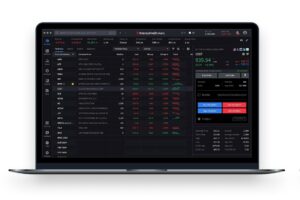The Dow Jones (US30) Index was down 0.22% on Wednesday. The S&P 500 Index (US500) was down 0.33%. The NASDAQ Technology Index (US100) closed lower by 0.79%. Stocks gave up early gains and suffered moderate losses as declines in chip company stocks impacted the broader market. AMD closed down more than 10%, leading to a decline in chip company stocks after fourth-quarter revenue guidance came in below consensus.
Better-than-expected US economic news on Wednesday boosted the outlook for a soft landing and lent support to the US dollar after Q3 personal consumption rose more than expected and the October ADP employment report showed employers added the most jobs in 15 months.
Shares of Garmin Ltd (GRMN) rose more than 23% and topped the S&P 500 leaderboard after the company reported third-quarter revenue of $1.59 billion, above the consensus estimate of $1.43 billion. Snap Inc (SNAP) closed higher by more than 15% after reporting 443 million daily active users in the third quarter, above the consensus projection of 441.16 million.
Equity markets in Europe were steadily declining on Wednesday. Germany’s DAX (DE40) fell by 1.13%, France’s CAC 40 (FR40) closed down 1.10%, Spain’s IBEX 35 (ES35) lost 0.68%, and the UK’s FTSE 100 (UK100) closed down 0.73%. European equity markets were set for declines on Thursday, marking the third consecutive session of declines as investors awaited preliminary inflation data from the region that could influence the European Central Bank’s approach to cutting interest rates. The overall inflation rate is expected to rise to 1.9% y/y from 1.7%, while core inflation (excluding food and energy prices) is expected to fall to 2.6% y/y from 2.7%.
Eurozone inflation will reach the European Central Bank’s 2% target during 2025, ECB President Christine Lagarde said in an interview with a French newspaper, largely echoing her recent statement.
WTI crude oil prices rose to around $69 a barrel on Thursday, extending gains of more than 2% from the previous session, helped by an unexpected decline in US inventories. EIA data showed that US crude inventories fell by 0.5 million barrels last week, contradicting market expectations of a 2.3 million barrel increase. However, bearish pressure remains due to weak demand from China (the largest importer), while investors are assessing the supply outlook following reports that OPEC+ may postpone its planned December oil production increase by a month or more.
Asian markets were mostly down on Wednesday. Japan’s Nikkei 225 (JP225) rose by 0.96%, China’s FTSE China A50 (CHA50) fell by 1.02%, Hong Kong’s Hang Seng (HK50) lost 1.55% and Australia’s ASX 200 (AU200) was negative 0.83%.
Hong Kong stocks were up 0.7% from Thursday’s market open, partially recovering from the previous day’s decline amid gains across all sectors. Traders reacted to official PMI data for October, which showed factory activity in China rose for the first time in six months following a series of new stimulus measures designed to reverse slowing economic growth. Meanwhile, growth in the services sector was solid.
The Bank of Japan (BoJ) unanimously kept its key short-term interest rate unchanged at around 0.25% at its October meeting. The BoJ remains bullish on further rate hikes if economic and price data matches its estimates. In its quarterly prognoses, the BoJ maintained its projection that core inflation will reach 2.5% in fiscal 2024, while inflation is expected to reach 1.9% in fiscal 2025 and 2026. As for GDP, the Central Bank maintained its growth estimate for 2024 at 0.6%. It also expects growth of 1.1% in FY 2025 and 1.0% in FY 2026.
Retail sales in Australia rose by 0.1% in September, well below the 0.7% increase recorded in August and below projections for a 0.3% increase as the positive effect of warmer weather in August wore off. In addition, a mixed quarterly domestic inflation report released earlier this week lowered expectations for an immediate rate cut by the Reserve Bank of Australia (RBA). Markets largely expect the RBA to keep rates at 4.35% at its upcoming meeting next week, with the first-rate cut not expected until May next year.









